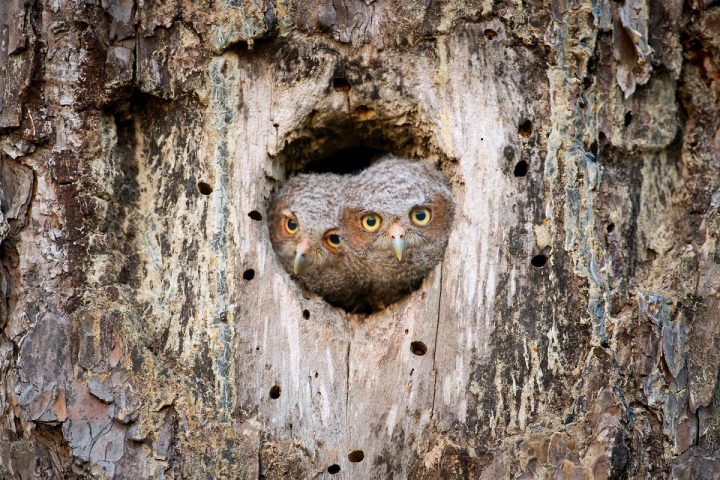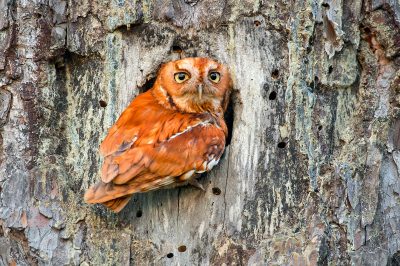
DEEP IN THE NATIONAL FOREST — I feel like this is cheating. I’m drinking coffee, sitting in my truck, watching what I am beginning to think of as owl TV on my tablet. Technically speaking, I’m working – technically speaking. My camera sits about 50 meters away. A 600mm lens is mounted to camera, mounted to tripod. Pretty standard setup for me. Only tonight there is a new accessory: the Camranger.
Writing this real-time if you will, I find myself glancing back and forth between screens. Two owl chicks shove their heads out of an old, abandoned red-cockaded woodpecker cavity in a longleaf pine. A mix of curiosity and impatience with the parental figures keeps them animated and me entertained. My tablet rests on a holder attached to my dashboard. Laptop is, well, sitting atop my lap. Owls. Words. Repeat.
Supporter Spotlight
The Camranger is a Wi-Fi transmitter that plugs into the camera via an HDMI cable and gives me complete control over settings remotely. I watch the world happening real-time seeing everything my camera sees through a dedicated app on my tablet. Two heads pop out? Adjust the focus by tapping the owlets on my tablet. Click. Dad comes flying in? Adjust focus again. Click. You can’t tell me that this isn’t a great time to be a photographer. With so many gadgets ranging from drones to this Camranger, the only thing holding us back are the limits of our own creativity.
The eastern screech owl graces the forest with a couple different color phases. The standard across most of its range is gray, making them one of the most perfectly camouflaged birds in the Americas when sitting in a tree – especially at the entrance of a cavity. The only other owl that comes close to this camo in the U.S. is the great gray owl. This is what makes the eastern screech, especially in the southern parts of its range, a peculiar bird though. If camo is paramount to survival, then the other color morph raises a few questions because it’s red.
We know two things about the red-colored screech owl that may help explain things. First, they are much more common in the southeastern U.S. than elsewhere. Secondly, there seems to be a correlation between this color and pine forests.

Today, the landscape of the Southeast is quite different than it once was. When Europeans first came stumbling through the forests of this place, what they encountered in the south was not the great deciduous forests we now think of, but instead, some 92 million acres of longleaf pine savannas. The global shipping industry would change all of that. Naval stores, that odd phrase collectively referring to forests products used in the maintenance of wooden ships, quickly became a leading industry across the South. Through the 1700s, more than 75 percent of the world’s supply of pitch, tar and turpentine was produced from North Carolina’s longleaf pines. Once the trees were “used up” and dying, the forests were clear-cut for timber. By the 1800s, the industry had laid waste to North Carolina’s longleaf pine forests and began moving south across the coastal plain. By the beginning of the 20th century, nearly 99 percent of this unique ecosystem that once stretched from Virginia to East Texas was no more.
The scale of this destruction may be historically unsurpassed. Not even logging in the Amazon has come close. An ecosystem that spanned the entirety of the southeastern coastal plain was wholly eradicated. And because the longleaf pine savannas both promoted and depended upon fire for its existence, once removed, it was replaced by other species and an entirely different ecosystem grew back in its place. Most people in the U.S. don’t even know this occurred. Today, oak, hickory and loblolly pine exist where once there was sweeping grasslands with longleaf pines spaced some 50-100 feet apart in an open and park like setting. Some ecologists believe that the complete destruction of the longleaf pine ecosystem is the greatest environmental disaster by our hands in our known history. I can already hear the gnashing of teeth by followers of the Pleistocene overkill theory.
Supporter Spotlight
So what does any of this have to do with red morph screech owls?
Disclaimer: what follows is only a working hypothesis of mine and does not necessarily represent the views of the editor, their housekeeper, or the mechanic at your local Toyota dealership. Before deciding to join a mob proceeding to my house wielding pitchforks and torches (I hate it when they bring the pitchforks), please remember this thoughtful disclaimer.
The longleaf pine is a particularly reddish-colored tree. Its bark is often a beautiful display of rufus-colored tones mixed with patterns of gray, especially those old trees infected with a type of fungus known as red heart rot. The fungus is important to the story because trees infected by this stuff are sought after by the red-cockaded woodpecker to excavate their cavities. Bear with me here.
The red-cockaded woodpecker is the only species aside from us that can create cavities in living longleaf pines. Because the composition of the longleaf forest promotes fire, there are very few dead standing trees at any given time in this ecosystem. For this reason, more than 40 different species of vertebrates are dependent upon this one woodpecker for their survival in this particular habitat that once spanned 92 million acres across the Southeast. The eastern screech owl happens to be one of those species.
When we look at a red morph screech owl, we may very well be looking at something of a genetic fossil. Genes that arose during a time when the longleaf pine forest was the dominant habitat type across the Southeast continue today even though the composition of those forests has been dramatically changed. Overtime, those same genes have spread northward into the population at large. But due to the lack of selective pressure working to promote this genetic characteristic however, the rufus-colored morph continues to be a minority outside of the South.
Back to photography, the situation in front of me is a simple one. I’m shooting straight-on at the cavity. There are three owlets inside. And mom and dad fly in and out from time to time with food, starting about an hour or so before sunset. The only problem is that I’m working remote, deep inside of a national forest. These are not suburban owls. This is the deep woods. I’m in a four-wheel drive vehicle, now covered in mud, required to even get back here.
Chances are, I’m the first human these owls have seen. And they are far less excited to see me than I am to see them. Let me get anywhere near the nesting cavity and both the chicks and parents stay hidden. Once I walk away, life returns to normal in a matter of minutes. It’s a sensitive situation. I’m working by the owls’ rules. No humans allowed.
Thus, in this situation, working from a remote device is better for the wildlife. It’s less stressful. Parents feel confident in coming into the cavity to feed their chicks. It’s the ethical thing to do. These owls have a tough time as it is without me playing wildlife paparazzi. I found a great horned owl nest earlier today only a quarter-mile away. These guys eat screech owls. And peregrine falcons. And, just about anything they can catch off guard. For the screech owl, odds are already stacked against them.
The sun has set and the colors are beginning to wash out as details become featureless. Lacking the requisite Tapetum lucidum in my eyes that give nocturnal species their characteristic eye shine, I have reached my limits of usefulness out here and prepare to give over the forest to those creatures of the night. The gray morph female flies back into the cavity one last time and disappears with her young for a few minutes. In the last bit of fading light, she climbs back up to the entrance of the cavity where she peers out into the forest with amber-colored eyes. Somewhere in the distance her mate, a red morph, begins to trill, joining the chorus of whip-poor-wills and the symphony of amphibians already beginning to crescendo.








